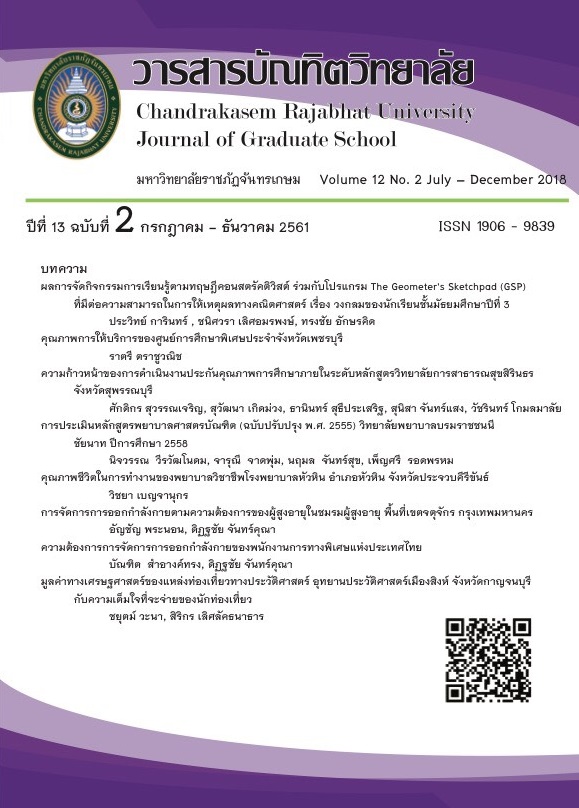The Needs of Exercise Management for Employees at Expressway Authority of Thailand
Main Article Content
Abstract
This research study aims at (1) investigating the needs of exercise management for employees at Expressway Authority of Thailand in the aspects of venues, equipment, and facilitation in types of exercise activities, management and servicing personnel and (2) comparing the needs of exercise management derived by gender, age, and division.
This quantitative study was conducted with 365 employees of Expressway Authority of Thailand. A Five-Likert-scale questionnaire was used to collect data. The data were analyzed by means, frequency, standard deviations, T-test, ANOVA analysis, and LSD (Least Significant Difference).
The results indicated that (1) the overall needs of exercise management for employees at Expressway Authority of Thailand were in the high level. Among each aspect of the needs, the results showed that the three aspects: 1) venues, equipment, and facilitation, 2) types of exercise activities, and 3) servicing personnel were in the high level while the management aspect was in the medium level. (2) Overall, different genders, ages, and divisions resulted in various needs of exercise management.
In conclusion, it appears that places to exercise, equipment, and the facilitation are needed the most. Moreover, there are statistically different for the needs between males and females and for those among different divisions of the employees. The study suggested that the Expressway Authority of Thailand should provide places for exercise center facilitated with full equipment and service to improve the life quality and the work effectiveness of the employees.
Article Details
References
2. กาญจนศรี สิงห์ภู่. (2555). การออกกำลังกายเพื่อสุขภาพของประชาชน. สืบค้น 23 ตุลาคม 2560, จาก http://www.srinagarindhph.kku.ac.th/index.php?option=com_content&view=article&i d=86:2011-11-09-06-40-59&catid=44:2011-06-13-02-42-42&Itemid=63
3. กุศล บุญสบ. (2551). สภาพและความต้องการการออกกําลังกายของผู้ออกกําลังกายในอําเภอเกาะยาว จังหวัดพังงา กรุงเทพฯ: มหาวิทยาลัยศรีนครินทรวิโรฒ.
4. ธวัชชัย สุกใส. (2550). ความต้องการการออกกำลังกายของประชาชนในเขตอำเภอเขาย้อยจังหวัด เพชรบุรี. กรุงเทพฯ: มหาวิทยาลัยเกษตรศาสตร์.
5. นงลักษณ์ ใจฉลาด. (2551). ศึกษาสภาพและความคิดเห็นต่อการออกกำลังกายและเล่นกีฬาของนิสิตมหาวิทยาลัยนเรศวร ประจำปีการศึกษา 2551. พิษณุโลก: มหาวิทยาลัยนเรศวร.
6. ประวิทย์ สุทธิบุญ. (2550). ความต้องการการออกกำ ลังกายของประชาชนในสวนสาธารณะของเขต เทศบาลนครอุดรธานี. กรุงเทพฯ: มหาวิทยาลัยศรีนครินทรวิโรฒ.
7. ประเวศ วะสี. (2551). สุขภาวะที่สมบูรณ. กรุงเทพฯ: หมอชาวบ้าน.
8. พวงรัตน์ ทวีรัตน์. (2540). วิธีการวิจัยทางพฤติกรรมศาสตร์และสังคมศาสตร์. กรุงเทพฯ: สำนักทดสอบทางการศึกษาจิตวิทยา มหาวิทยาลัยศรีนครินทรวิโรฒประสานมิตร.
9. เพ็ญแข คุณาเจริญและกรองทอง ชวลิตธำรง. (2551). พจนานุกรมไทยวัฒนาพานิช อังกฤษ-ไทย. กรุงเทพฯ: ไทยวัฒนาพานิช.
10. เรืองศักดิ์ ศิริผล. (2542). การออกกำลังกายกับการควบคุมโรคความดันโลหิตสูงโรคเบาหวาน โรคหัวใจขาดเลือด. กรุงเทพฯ: ชุมชนสหกรณ์การเกษตรแห่งประเทศไทย.
11. Schiffman, Leon G. and Kanuk Leslie Lazar . (1991). Consumer Behavior. (4th. ed.). New Jersey: Englewood Cliffs.
12. อรษา คชสีห์. (2550). ความต้องการออกกำลังกายของนักศึกษามหาวิทยาลัยเทคโนโลยีราชมงคล (วิทยานิพนธ์ ศึกษาศาสตร์มหาบัณฑิต). กรุงเทพฯ: มหาวิทยาลัยรามคำแหง.

